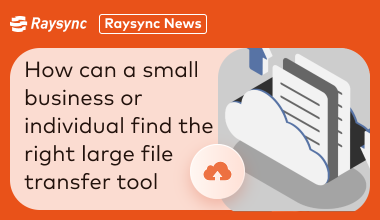How to Make File Transfer More Secure?
In fact, today's business is increasingly driven by data. In order for your organization to be successful, it is important not only to send, but also receive, and access large amounts of data securely. However, the more you transfer, the greater the possibility of file security issues.

So what would you do? As the saying goes, the best offense is a good defense. Although in many ways, the right communication solution can help. how should we better ensure the security of file transfer?
Knowledge is the key. With the boom in the use of private chat applications, sharing data with a finger tap has become second nature. We quickly share GIFs, pictures, music, videos, documents, and sometimes sensitive data; usually not verifying the content or intended recipients, or worse, considering the consequences of sending the wrong content to the wrong individual.
First, you need to be trained on the risks of transferring data. All your employees play an indispensable role in the security of the organization. Therefore, every employee must know why it is vital that every file is kept in the right hands.
Transferring data on a private peer-to-peer network is a more secure option. Sending and receiving files peer-to-peer keeps sensitive data on your network. By avoiding middlemen, you can avoid potential error handling and malicious external threats. In addition, Raysync is faster than cloud sharing. Just drag and drop the file into the chat window, as long as you have a stable internet connection, and voila. No additional login. No upload and retrieval. No need to increase bandwidth.
This means being able to enable and disable features (including file transfer) for individuals, user groups, or all users. Importantly, it also means taking advantage of these functions. In this way, you can rest assured that your employees can use the platform efficiently and appropriately.
You might think that a separate file transfer solution can provide you with better security. But it is still limited to one function. In fact, your file transfer is not the only aspect of internal communications you need to protect. Your text and group chats, voice, and video calls also need to be protected. If they happen on different platforms, the possibility of carelessness, error, and impropriety will only increase. Simplifying all communications on one platform is a better way to ensure that data stays in good condition, no matter how the data is transmitted.
Protecting your data in today's hyper-connected world is no easy task. Although you cannot keep you alert for a second, your team must always pay attention and remain alert. But by paying attention to these tips, you can better protect file transfers while protecting your team communication.
You might also like

Raysync News
March 13, 2024How can a small business or individual find the right large file transfer tool?
With the file transfer needs of individuals and small businesses also changing, transferring and sharing large files efficiently and securely is an increasingly common challenge. Finding the right large file transfer tool is especially important.

Raysync News
October 20, 2020Hurry Up! Schedule with Raysync on 2020 NAB Show New York
Come to schedule with Raysync on NAB show with pass code NY0712, and you could chat with our sales in real-time for any problems of the large file transfer.

Raysync News
August 27, 2020Best File Sharing Solutions for Small Businesses
In the past, if you are tried to share a large file, there had two options. 1: Using a file-sharing service, which was a risk at the time. Or 2: Copy the file to a disk and hand (or mail) it to the recipient.